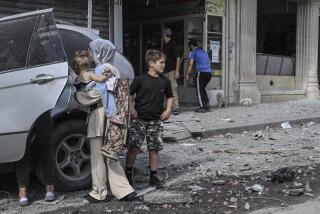Kinsley: The killing drones on

- Share via
The most famous painting of the 20th century, Picasso’s “Guernica,” commemorates the 1937 bombing of this small Spanish town by the German air force, in support of Gen. Francisco Franco’s fascists in the Spanish Civil War. Hard to believe, but this was history’s first extensive bombing of a civilian population.
In his book “Postwar,” historian Tony Judt pointed out that more civilians died in World War II, of various causes, than did soldiers. That was not true of World War I or of most earlier conflicts.
Guernica was a German dress rehearsal for the London blitz, the destruction of Warsaw and so on. Soon to come on the Allies’ side were the destruction of Dresden, the firebombing of Tokyo and, of course, Hiroshima and Nagasaki. Today when we think of war, bombing from skies is one of the first images that come to mind.
One consequence of this and other developments in warfare has been a blurring of the distinction between soldiers and noncombatants. Wars used to be conducted on battlefields, between soldiers in uniforms lined up in rows, bayonets ready. People famously took picnic baskets to watch the first battle of Manassas, thinking that the U.S. Civil War would be like that. It wasn’t.
The war on terror’s contribution to this unfortunate history has been the drone: an unmanned plane that can aim at and hit a target with enormous precision. And, as with earlier developments, we’re getting used to it. The eye passes right over headlines buried inside the newspaper such as this one that ran in the New York Times on Dec. 28: “Yemen: Drone Strike Kills 2.” Right now we have more or less a monopoly on drones, but that won’t last any longer than our monopoly on nukes did.
The advantages of using drones are obvious. No American lives are put at risk, and the precision minimizes “collateral damage,” including the deaths of innocents who happen to be nearby. The disadvantages follow from advantages. When a military option seems less painful, it is more likely to be resorted to. The ability to strike at the enemy with absolutely no risk to your own people must be especially appealing to politicians like President Obama, for whom the decision to put Americans “in harm’s way” is surely the toughest one to make.
But drones also highlight a terrible anomaly of civil-libertarian societies: the contrast between how we treat killing — state-sponsored killing — in battle, and how we treat killing in civilian life. Obviously, there are no Miranda warnings in the trenches. In fact, the entire edifice of protections against convicting the innocent is irrelevant in battle. You kill the other guy because he’s trying to kill you, and unless you’re raping women or murdering babies, you’re going to get a medal, not criticism. “Collateral damage” — including the deaths of complete innocents — comes with the territory.
Once upon a time, these two spheres were completely separate, with one set of rules — if that — for the battlefield, and one for normal times and places. Now every place is the battlefield. The World Trade Center, for example.
Why is it not only OK but praiseworthy for the U.S. government to aim at Anwar Awlaki and kill him because he is an Al Qaeda “operative” who may not actually have killed anyone directly (though no doubt he’d have liked to), while Adam Lanza, who shot and killed 20 schoolchildren and seven adults, including his own mother, before killing himself, could have had, if he’d lived, a trial that lasted weeks and cost millions of taxpayer dollars? What about the person riding in Awlaki’s car who was killed with him? What about Awlaki’s 16-year-old son, who died in a drone attack two weeks later? Awlaki was a U.S. citizen and his child was born in Colorado, if that makes any difference.
The Obama administration’s position is that it has looked at this carefully and there’s no legal problem with drone assassinations for reasons that regrettably must remain secret. U.S. District Judge Colleen McMahon’s wonderfully acerbic decision, issued last week, reluctantly acknowledges the administration’s right to maintain this absurd position: A “thicket of laws and precedents,” she writes, “effectively allow the executive branch of our government to proclaim as perfectly lawful certain actions that seem on their face incompatible with our Constitution and laws, while keeping the reasons for their conclusions a secret.”
As is so often the case, Stalin may have said it best (if, indeed, he really said it): “One death is a tragedy; a million deaths is a statistic.” The deaths of Awlaki and Lanza may not be tragedies, but the differences in how we think about them deserve better than a “because we said so” — especially from a liberal Democratic administration led by a former president of the Harvard Law Review.
I wonder especially about the teenage son killed in a separate drone attack, and the two killed just before New Year’s, according to Reuters, because they were “suspected of being insurgents linked to Al Qaeda.”
Is that good enough for you?
Michael Kinsley, a former editorial page editor of The Times, is a Bloomberg View columnist.
More to Read
A cure for the common opinion
Get thought-provoking perspectives with our weekly newsletter.
You may occasionally receive promotional content from the Los Angeles Times.










